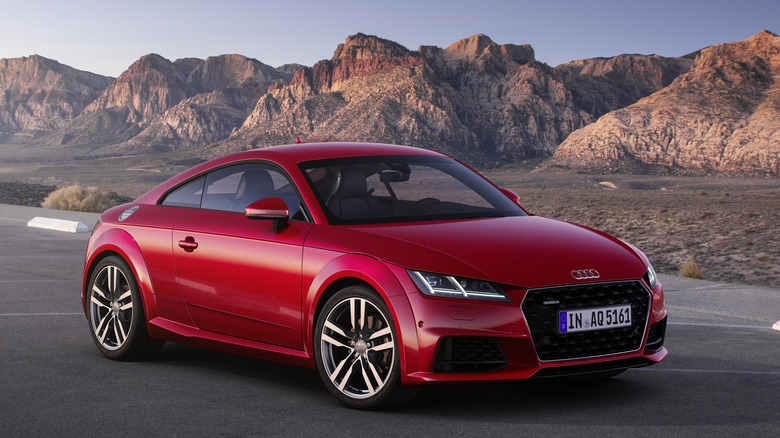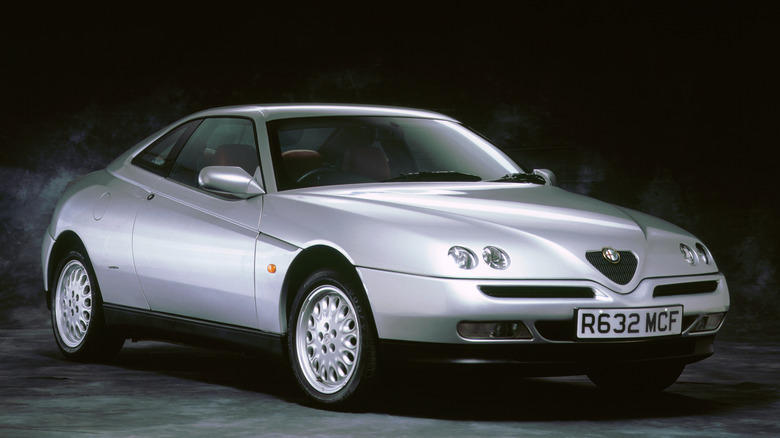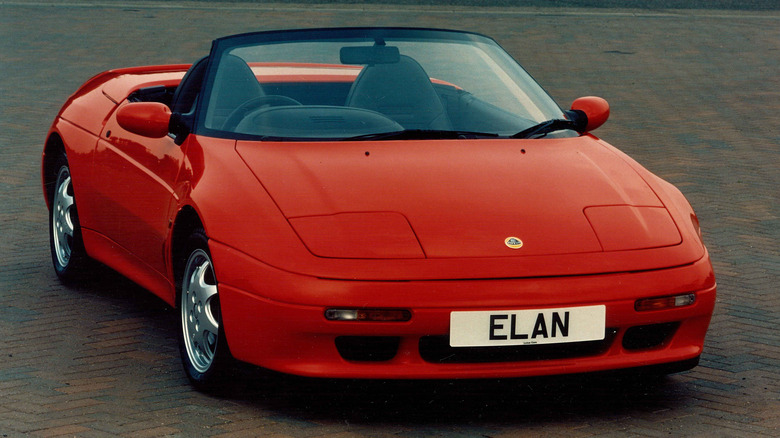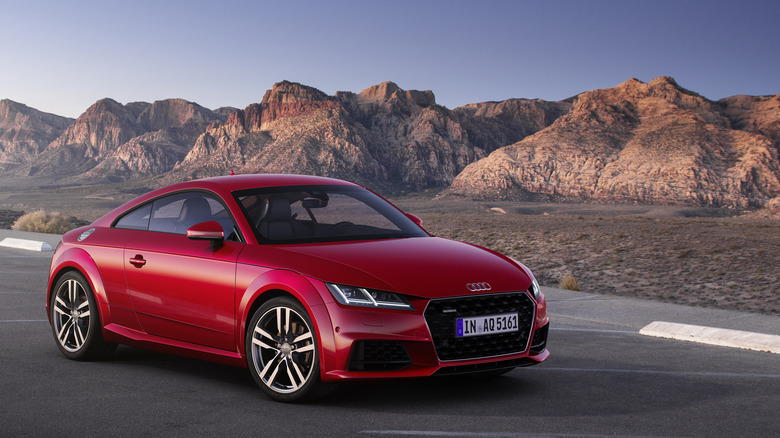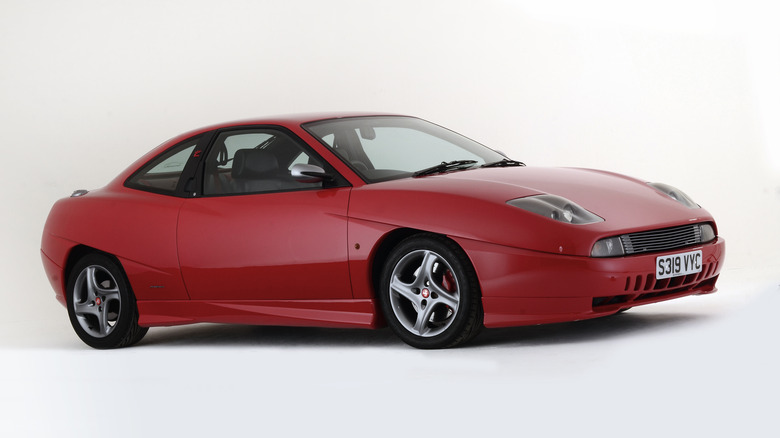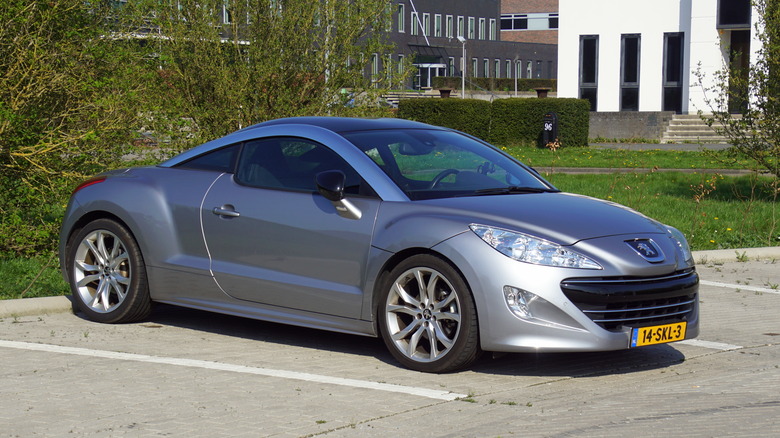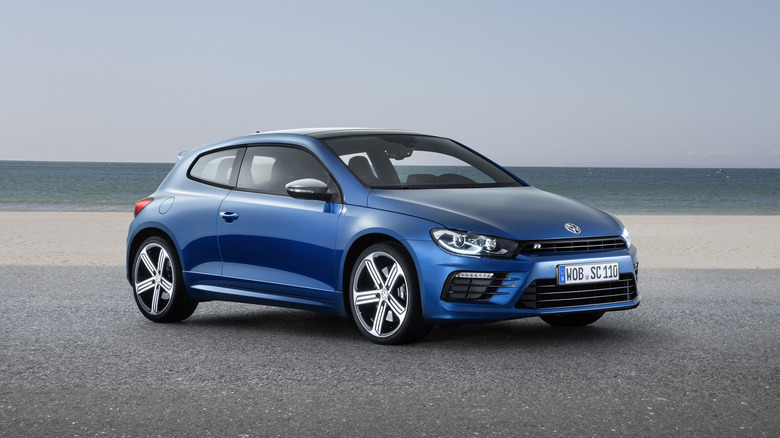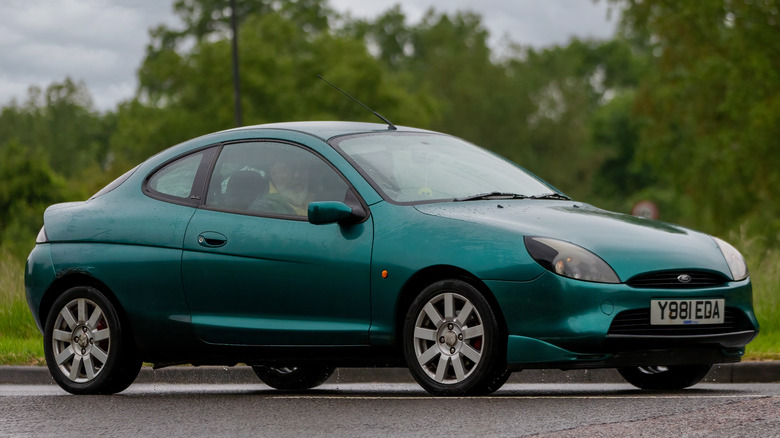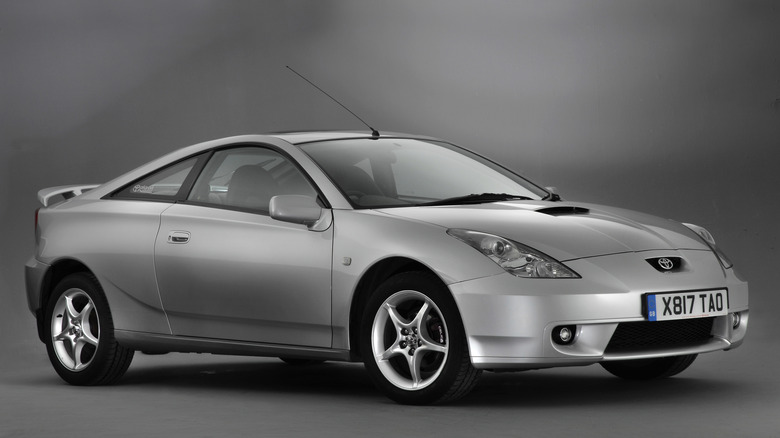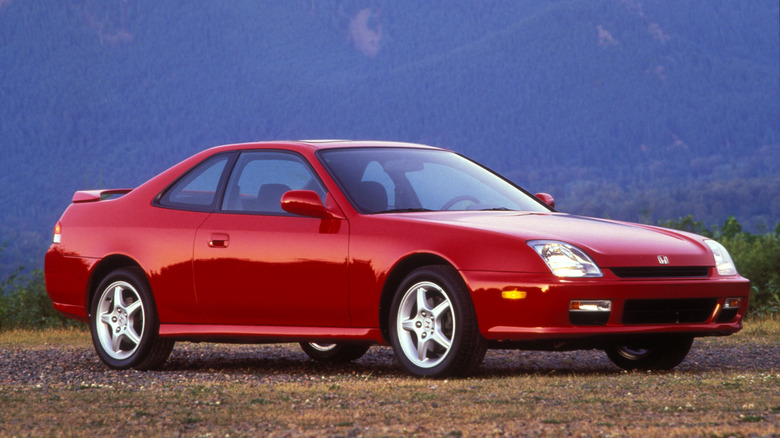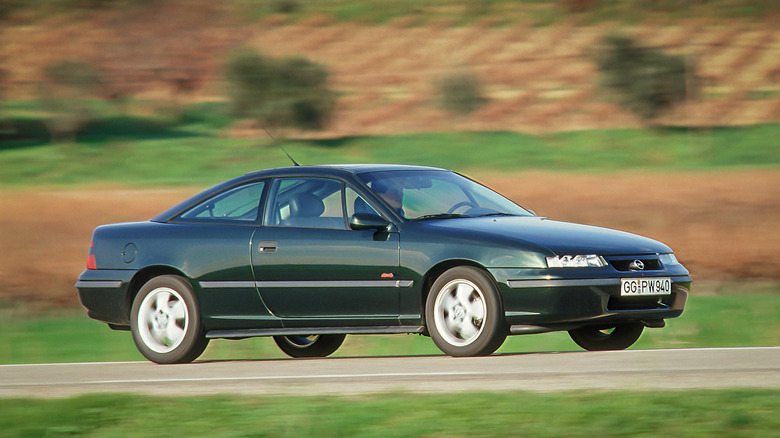10 Front Wheel Drive Sports Cars That Prove FWD Is Not For The Feeble
We've heard it a million times before: for a sports car to get any sort of street cred from car enthusiasts, the engine has to spin the rear wheels and only the rear wheels. You can debate this until the middle of next week, but even if you don't care about things like weight distribution or understeering, it's tough to argue that some of the very best sports cars and performance cars throughout history have been RWD. Porsche Caymans, Toyota Supras and MR2s, BMW M3s, and all the other stuff that enthusiasts are ready to part ways with several paychecks for.
The fact remains, however, that some more of the best-driving cars throughout history have driven the front wheels. The Peugeot 205 GTI and various generations of the Golf GTI, for example. So what exactly is the matter with taking those solid FWD platforms and sticking them in a sporty coupe body? Jeremy Clarkson may have said that FWD is for the feeble, but with the right ingredients, it doesn't need to be. Here are some cars that prove it.
Alfa Romeo GTV (916)
In 1974, Alfa Romeo blessed the automotive world with the Alfetta GT and GTV, some of the most beloved models in the company's history. In a bid to expand its lineup, Alfa brought back the GTV and Spider nameplates for model year 1993, with one vital aspect missing: a rear-driven platform. The Type 916 GTV was FWD, based on the same Tipo Due platform as the Fiat Coupe, and thus the much smaller Alfa 145, and even the Fiat Tipo.
Despite the switch to the devil's drive wheels, the GTV had everything else you might expect from an Alfa. The Pininfarina-penned styling was beautiful, and only Alfa could pull off tiny headlights (which weren't actually two separate circles) without sacrificing the car's overall appearance. The sharp styling line down the side and the rear light bar are also highly distinctive. The GTV wasn't just all show and no go, however.
Power came from a plethora of different powertrains, including four-cylinder Twin Spark units and the very special Busso V6, displacing either 2.0 liters, 3.0 liters, or 3.2 liters. All of that was paired up with a platform more than ready to handle spirited driving, with MacPherson struts in the front and a multilink setup in the rear that was exclusive to the GTV.
Lotus Elan (M100)
Simplify, and add lightness. The famous mantra of Lotus founder Colin Chapman may not be quite as prevalent nowadays, but 30 years ago, that's what it was all about. Lotus fans can't seem to get enough of the Elise and the Evora, neglecting some of the other gems from Lotus' illustrious history. One of those gems is the final generation of the Elan, internally named the M100.
Like most other British boutique car manufacturers, Lotus was strapped for cash by the 80s, leading to an acquisition from General Motors. With healthy investment from the American automotive giant, Lotus finally brought back the Elan. It featured all-new styling, riding the wave of more rounded wedge shapes that would soon become the de facto styling trend of the 90s. Under the hood lay a pretty bulletproof Isuzu powertrain and... FWD?
Yes, the M100 Elan drove the front wheels only. People would be quick to call that sacrilege, but it wasn't as bad as it sounds. You couldn't exactly have much drifting fun with the Elan, but it was still a joyous experience, thanks in no small part to the total lack of any significant weight. Interestingly, the Elan eventually would replace the Lotus badge with a Kia badge after the Korean manufacturer licensed it.
Audi TT
Audi absolutely wowed the world in 1995 with the TT concept. It was a small sports car concept with styling straight out of any cyberpunk comic book you can think of. Despite no initial plans for production, the world begged Audi for a production version of the TT Concept. To everyone's surprise, it actually followed through, introducing the production TT for model year 1998.
Underneath the showstopping exterior, all three generations of the Audi TT used humble underpinnings from the Golf. The original car, despite being a little softer than you might expect for a sports car, was very composed and great fun to drive. Unfortunately, the initial run had to be recalled because their slippery bodies ended up causing fatal high-speed accidents.
Today, the TT is an absolute icon, and certainly on its way to becoming a classic car. Dozens of special editions were launched, including more powerful versions of the original 1.8 turbo cars, paired up with AWD, the 3.2 VR6 in the TT 3.2 Quattro, the highly sought-after TT Quattro Sport, and of course, the world-beating TT RS. Sadly, after turning 25, the Audi TT officially ended production. While the Audi TT as we know it is officially over, the original is a legend, and it will always be known for making waves in the world of the small sports car.
Fiat Coupe
One of the more notable cars to ever be labeled a mini Ferrari, and one that definitely deserves it, is the Fiat Coupe. Launched in 1993, the Coupe was based on the same Type Two platform as the Alfa GTV and the super angular design was penned by Chris Bangle, the famous designer of many iconic BMW cars.
The Coupe may have been based on the same platform, but it was meant to appeal to a completely different audience. For one, the V6 powertrains of the GTV were nowhere to be seen, but in their place was something even more interesting: a turbocharged five-cylinder engine. There were a couple of four-cylinders available, but the I5 is the cream of the crop for the Fiat Coupe.
217 hp made it to the front wheels in the most powerful 20V Turbo version of the Coupe, allowing for a 0-60 time under 7 seconds and some fabulous noises coming out of the back. Today, the Coupe remains a curious piece of Fiat's history, and it's definitely something to shortlist whenever the itch for a cool European import must be scratched.
Peugeot RCZ
In 2007, Peugeot took the whole world by surprise when it showed off the 308 RCZ concept. As is so often the case with concept cars, Peugeot had no plans to put it into production, but it was very difficult to ignore the overwhelmingly positive reception. The production car would drop the 308 part of the name to just become the RCZ, and the first cars started rolling off the line in 2009. As is often not the case, the RCZ looked pretty much identical to the concept car.
However, the RCZ still shared a lot of its underpinnings with the humble 308 hatchback. This was clearly Peugeot's answer to the Audi TT — the two cars followed the same basic design outline, and both of them built upon the platforms of their hatchback stablemates. With Peugeot's E-Lion EV plans set for at least the next 5 years, the chances of a new RCZ in the coming years are slim to none.
The RCZ was available with a lineup of turbocharged engines, the gas units being part of the Prince family also used by the Mini Cooper. There was also a diesel version, but no one really bothered with it. Unlike basically every Peugeot of the time, the RCZ was also apparently a blast to drive, regardless of powertrain. With around 50,000 units produced, the RCZ has the potential to go up in value, much like the Audi TT already has.
Volkswagen Scirocco
As it turns out, leveraging existing FWD platform components to make a sporty coupe is quite a good idea. The Volkswagen Scirocco is another prime example of a vehicle that's more than the sum of its parts. From the first generation, all the way to the last one, the Scirocco was based on the humble Golf, using some components from other VW models.
The first Scirocco arrived in 1974 to replace the fabulous Karmann Ghia. Giorgetto Giugiaro was responsible for the design, and the Golf's powertrains were carried over into the Scirocco, including the excellent 1.6-liter I4 in the GTI. The Scirocco II came along in 1981, improving the performance and the looks, and making everyone who grew up playing "Midnight Club: Los Angeles" cry with nostalgia when they see one.
In 2008, Volkswagen revived the line one last time, following the same basic principles: The final-generation Scirocco and Scirocco R featured Golf underpinnings, a sporty three-door body, and plenty of performance and handling prowess. Sadly, the final Scirocco rolled off the line in 2017. Apparently, Volkswagen is poised to bring back the Scirocco as an electric sports car based on the upcoming Porsche Boxster/Cayman EV. A grain of salt is necessary here, but that sounds like a fantastic idea.
Ford Puma
Ford is yet another automaker guilty of bringing back the name of a performance car, only to then stick it on the back of a small crossover. The Puma ST SUV is only available in Europe, so North American drivers are missing out, but the original car that wore the Puma name is far more interesting anyway. Launched in 1997, it was based on the fourth-generation Fiesta. The Fiesta received plenty of praise for its well-sorted chassis, so why not make a sports car out of the same hardware?
Sporty car although the Puma was, it was certainly no high-performance automobile. The base engine put out just 90 hp, and even though you'd have lots of fun getting to your destination, you probably wouldn't get there quickly. The coolest version of this little pocket rocket has to be the Ford Racing Puma.
Using the regular Puma as the starting point, the Racing Puma upped everything to 11. A more powerful version of the 1.7-liter four-cylinder put out a healthy 150 hp, which was plenty in a tiny car weighing less than 2,300 lbs. An uprated gearbox, a much stronger braking system, and an optional LSD rounded off the package. Only 500 of the Racing Pumas were ever made, and it remains an underrated Ford with all the makings of a future classic. Plus, regular Pumas with the more powerful engine are still dirt cheap.
Toyota Celica
For those who want a RWD Toyota sports car, there's no shortage of Supras or MR2s out there. Serious money is required for the privilege, but there are tons of options. The Celica has been neglected for years, and that's a shame. It goes to show that if Toyota concentrates, it can make just about any sort of sporty car handle well.
Although the Celica was RWD for the majority of the time, by 1989, it switched over to a FWD platform. The fourth-generation Celica conquered just about every global rally stage you can think of, so most people are quick to judge the car's final generation, which never really received a high-performance version like the Celica GT-Four. However, the T230 Celica offered something different.
One of the car's available powertrains was the 2ZZ-GE 1.8-liter NA four-cylinder. This is the same engine that powered the Pontiac Vibe GT, and more importantly, the second-generation Lotus Elise. This engine had Toyota's VVTL-i system, very similar to Honda's VTEC. More revs equaled more power, and there was plenty of headroom in the rev range: 7800 rpm was the redline, in fact. Despite the seemingly lowly 180 hp, the Celica was all about the drive. While the drive was good, it wasn't the absolute best.
Honda Prelude
No matter what type of car it is, Honda tends to always make sure that driver involvement and good handling are at the top of the priority list. Launched in 1978, the Prelude was to Honda what the Celica was to Toyota, except the Prelude was FWD right from the very beginning. Rather than borrow its underlying components from the Civic, the Prelude was based on the Accord, but it had a shorter wheelbase.
Over time, the Prelude would get redesigned numerous times, including the fabled second-generation car — the one with pop-up headlights. Later generations of the Prelude would also gain something that the competition never offered: four-wheel steering, available on the fourth-generation car. Honda's sporty FWD coupe would culminate in the late 90s with the fifth-generation Prelude, as well as the highly sought-after Type SH.
Powered by the H22 2.2-liter I4 putting out 200 hp, the Prelude Type SH was only offered with a five-speed manual transmission. While there was no four-wheel steering, the Prelude Type SH substituted that with the Active Torque Transfer System, or ATTS. To avoid a daily science lesson, it was an early form of torque vectoring, which sharpened up the handling significantly. It's no wonder that a pristine Prelude nowadays is worth some pretty good money, and we're so glad to see that it's coming back as a hybrid concept.
Opel Calibra
During the 80s and 90s, German automaker Opel, formerly owned by General Motors, put out some truly spectacular cars. The Lotus Omega/Carlton was so fast that it was almost banned, and Opel's performance car offering got a lot sweeter in 1989 with the introduction of the Calibra. Similar to the Prelude, the Calibra used the underpinnings of its contemporary, the Vectra, sleeving them in a gorgeous, super aerodynamic body. A drag coefficient of 0.26 Cd is still impressive today, but it was especially impressive back in the late 80s and early 90s.
Power came from a small lineup of Opel-engineered engines, the most sought-after of which being the 2.0-liter turbocharged I4 putting out 204 hp, which was paired exclusively with a six-speed manual transmission. Eventually, the Calibra would also add AWD, which became its rarest version. It was also quite good on the race track.
Today, the Calibra is a pretty hot item, like a lot of other sporty cars from the 90s, though it has remained relatively affordable. Disappointingly, Opel would never follow up with a second-generation Calibra, opting instead for a second-generation of the far worse-received Tigra. It's highly unlikely that we will ever see a second-generation Calibra, but the original will always remind us that Opel used to be awesome.
